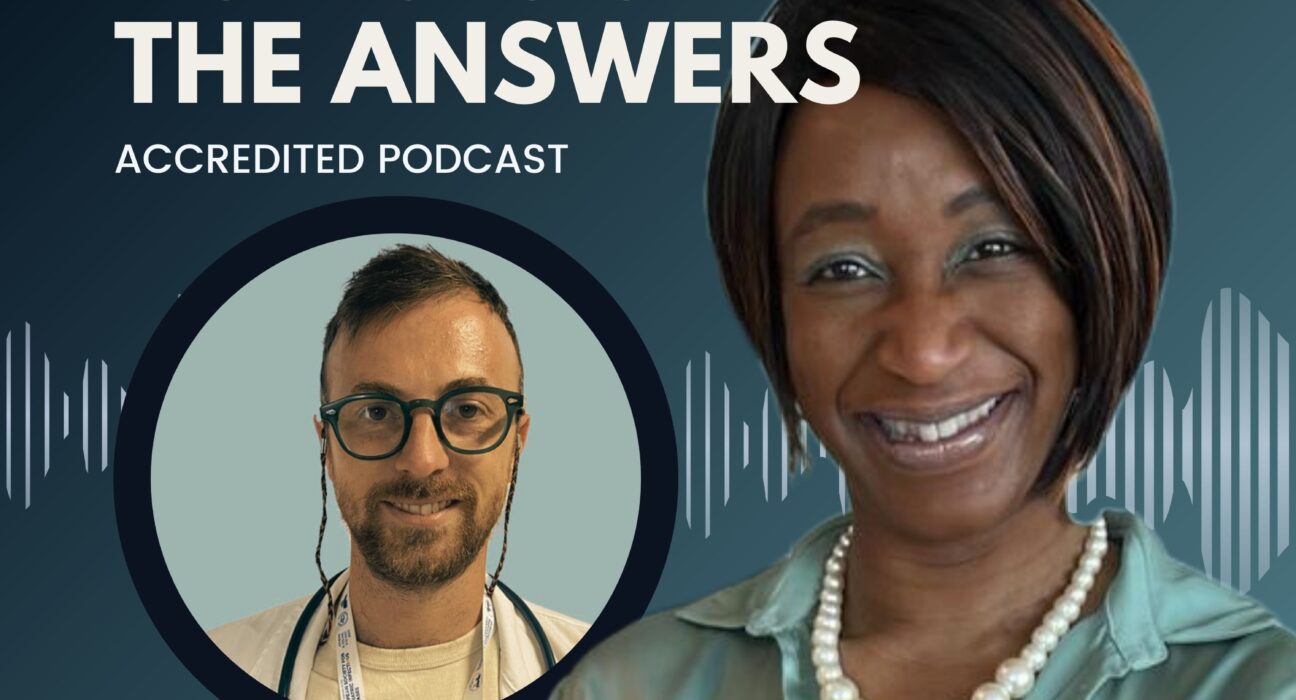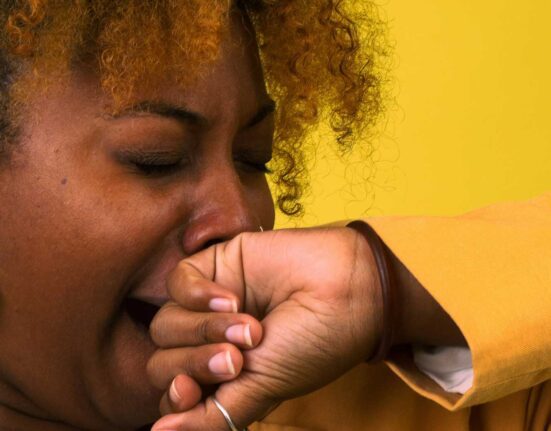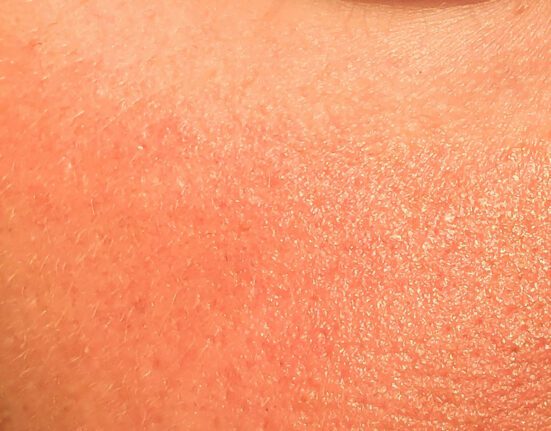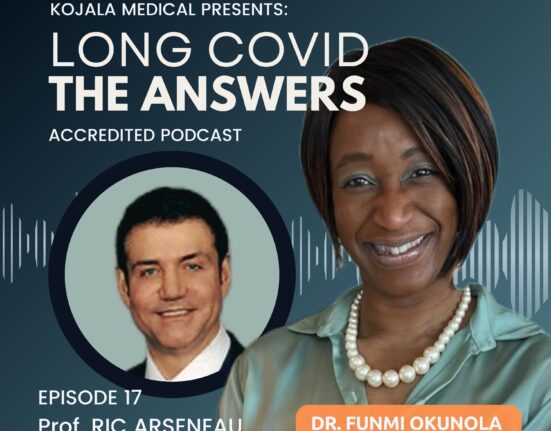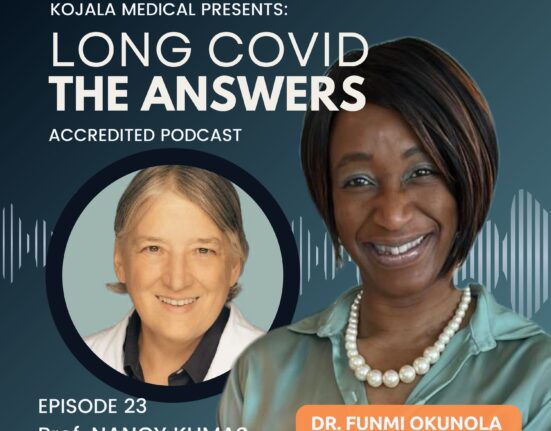
Dr. Danilo Buonsenso, an expert in pediatric infectious diseases, discusses Long COVID’s significant impact on children, the misconceptions about minimal effects, and his ongoing research. Despite lower percentages compared to adults, millions of children globally face severe outcomes including acute infections, MIS-C, and Long COVID, as confirmed by studies and parent testimonials. Buonsenso’s work aims to identify biomarkers for diagnosis and treatment, with results expected soon.
Guest – Danilo Buonsenso
Note: The podcast has no bias. All conflicts of interest are highlighted with individual guests.
Healthcare Professionals | Earn 0.5 Certified Mainpro+® Credits! Please register/login to claim your CPD/ CEU credits.
Podcast Overview:
Dr. Danilo Buonsenso discusses the complexities and impacts of Long COVID in children. Dr. Buonsenso, a pediatric infectious disease specialist at Gamelli University in Rome, has conducted extensive research on the clinical effects of SARS-CoV-2 in children, including acute disease, MIS-C, and Long COVID. He emphasizes the importance of recognizing that while children may have a lower risk of severe COVID-19 outcomes compared to adults, this does not equate to no impact.
Dr. Buonsenso outlines three major outcomes of COVID-19 in children:
- Acute Disease: Though less common than in adults, some children have experienced severe illness or death from acute COVID-19.
- Multi-System Inflammatory Syndrome in Children (MIS-C): This serious condition has resulted in significant morbidity and mortality in children worldwide.
- Long COVID: Persistent symptoms such as severe fatigue, cognitive issues, and chronic pain have been documented in children globally. Parents’ testimonials, observational studies, and various research efforts provide evidence for these ongoing issues.
- Dr. Buonsenso’s research involves long-term follow-up and personalized diagnostic approaches, including blood samples and cardiopulmonary exercise testing, to understand the mechanisms behind Long COVID. Preliminary findings suggest that children with Long COVID show distinct blood signatures compared to healthy controls, pointing to persistent immune activation and potential biomarkers for the condition. The full research results are expected to be published within the year.
DISCLAIMER: The information in this podcast is provided for informational purposes only. You should not use any information discussed in this podcast and related materials to make medical or healthcare related decisions. Always consult a your physician or other qualified health care provider with regards to diagnosing managing your medical condition. Any medications or treatments, including any discussed in this podcast, should be initiated and managed by a qualified health care professional.
Podcast Transcript:
Healthcare Professionals: Please note to claim Certified CPD / CEU credits toward your medical license (Canada & reciprocal CPD/CEU Worldwide), you will need to register or log in.
Understanding the Underlying mechanisms of Long COVID in children with
Dr Danilo Buonsenso MD, PhD.
[00:00:00] The information in this podcast is provided for informational purposes only. You should not use any information discussed in this podcast and related materials to make medical or healthcare related decisions. Always consult your physician or other qualified healthcare provider with regards to diagnosing and managing your medical condition. Any medications or treatments, including any discussed in this podcast should be initiated and managed by a qualified healthcare professional.
Introduction to Pediatric Long Covid
Funmi Okunola: Welcome to Long Covid The Answers. Today’s Episode Three is entitled “Understanding the Underlying Mechanisms of Long Covid in Children” and is the first of a two part series of episodes about pediatric Long Haulers.
Meet Dr. Danilo Buonsenso MD PhD
Funmi Okunola: I’d like to introduce Dr. Buonsenso who is a physician scientist and a specialist in Infectious Diseases in children.
Dr. Buonsenso currently works at the Department of Women, Child and Public Health at the Gamelli University in Rome, Italy. He has a PhD in Public Health and Biomolecular Sciences and is currently doing his MSc in Infectious Disease at Oxford University. During the pandemic his work extended to the clinical impact of SARS-CoV-2 infection in children from acute disease, Multisystem Inflammatory Syndrome in Children, or MIS-C and Long Covid. He is a founder and president of the not-for-profit organization, Surf for [00:01:00] Children, which provides medical support for children in Sierra Leone and special needs support for children in Italy. He is also a champion of the charity Long Covid Kids. Welcome.
Danilo Buonsenso: Thank you for your introduction. It’s my pleasure to be here.
Funmi Okunola: Oh, it’s our pleasure to have you. Do you have any conflicts of interest to declare Danilo?
Danilo Buonsenso: Yes, I have some to declare. I am currently coordinating a project about Long COVID in children – two projects actually, which have been funded by Pfizer and Roche. They had no role in planning or developing the project, nor in the interpretation of the results.
Funmi Okunola: Okay, thank you for that. I just wanted to ask you casually how do you fit in so many things? We’re ever so grateful for all the work you do, but you do amazing work, and you’re one of the few people, very few people online, that give regular updates on your Substack, with regards to what’s [00:02:00] happening with Long COVID in children.
How do you find the time, because you’re an active clinician too?
Danilo Buonsenso: Yeah, it’s probably because it’s something that really fascinates me, all this Long COVID and post viral world, not only interests me as a pediatrician and as a parent, but also, in my opinion, Long COVID is opening our eyes and our mind about how little we do understand so far about the potential long term outcomes of viral infection.
In my opinion, a new era is literally starting in this field, which is going in parallel with new discoveries about the link between Epstein Barr virus infection and Multiple Sclerosis or, the protection of shingle vaccines against neurodegenerative disorders. So really literally a new era is starting. Long COVID is the latest chapter and this really [00:03:00] fascinates and motivates me to be updated and update my patients, even my colleagues on this topic, and this is maybe how I find the energy.
Funmi Okunola: Well, that’s fantastic.
Defining Long Covid in Children
Funmi Okunola: If we start with World Health Organization’s definition of Long COVID published in February 2023, which states that the post COVID-19 condition in children and adolescents occurs in individuals with a history of confirmed or probable SARS-CoV-2 infection, when experiencing symptoms lasting at least two months, which initially occurred within three months of acute COVID-19.
It’s commonly believed that COVID has minimal impact on children, and that they hardly become infected. Can you please comment on that?
The Impact of Covid on Children
Danilo Buonsenso: So, yes, definitely. You raised two important points with the definition from the WHO, but also on this other comment about what is thought that [00:04:00] COVID in general is causing minimal impact.
This is a kind of narrative that created a lot of confusion among the public, but also researchers, because the point has been that the impact of COVID in adults has been so massive that a much less impact in children has been interpreted by most as no impact. But this concept has been translated wrongly, of course, as no impact in children at all, and this is not true for a number of very obvious reasons. So, first of all, the acute infection, the acute disease has killed children or brought children within the pediatric intensive care unit.
So, first of all, we have had some children suffering a lot or even dying from acute infection. So, it’s probably the 0.01% of this outcome compared to adults, but still, this has been [00:05:00] one of the leading causes of death and pediatric intensive care unit admission in children in terms of acute disease.
Secondly, we have had all over the world, children developing the Multi-System Inflammatory Syndrome, which is a multi-system disease characterized by multi organ dysfunction that has been clearly linked with previous SARS-CoV-2 infection, and again, this disease has killed children all over the world, and brought children in pediatric intensive care units. Again, much less compared with adults, luckily, but much less does not mean no impact at all. Then the third significant and serious outcome is Long COVID. This outcome in children has been neglected for one or two years. Still some people from the public, politics, or even from healthcare settings, still negate this problem. [00:06:00]
But it is a fact that Long COVID has been documented in children everywhere in the world, in high-, low- and middle-income countries. This is another outcome that still can involve children. Again, most probably, the risk of Long COVID in children is less compared to young adults or middle-aged adults, but less again is not zero negative impact in children.
This difference in comparison with adults created a lot of misunderstanding and these also impacted how parents, for example, may have decided to take some preventive measures. This has clearly impacted the communication within the media.
So, less impact is different from no impact in children.
Funmi Okunola: I’d also like to point out a couple of things. So, for my reading, SARS-CoV-2 is in the top three causes of death, reasons for children to be hospitalized or end up in the ICU. I’m going on U. S. figures [00:07:00] here and also during the Omicron variant, I remember that about a quarter of a million children in the U.S. were being admitted to hospital every week. I think even though it’s been less impactful, as you say to adults, I think people don’t really have a concept on the numbers. That’s a huge number of children, and I’m just talking American figures.
Danilo Buonsenso: No, that is the same worldwide. So, the figure you gave for the US is very much similar all over the world.
The point is that in terms of proportion, a little, a very little percentage of children that got SARS-CoV-2 infection required hospitalizations or pediatric intensive care unit. But the problem is that the denominator was huge. So even the 1% of actually 100% of children having had COVID sooner or later during the pandemic means as an absolute number [00:08:00] a huge number of children that required hospitalizations, a significant number of children requiring pediatric intensive care units, again, a significant number of children dying because of this disease or Multi System Inflammatory Syndrome.
As well as a significant number of children being chronically disabled because of Long COVID. So, the risk percentage is minimal. The absolute numbers are huge globally because millions and millions of children met the virus sooner or later during the pandemic.
Funmi Okunola: Okay. Thank you so much, Danilo, for that.
Evidence of Long Covid in Kids
Funmi Okunola: What proof is there that Long COVID affects kids?
Danilo Buonsenso: So, the proof is from several different levels. I will start with testimonials by parents and patient’s associations because many times people refer to randomized control trials as the best study designs, but [00:09:00] people forgot that parents know these children.
Parents, and in general patients have been the first one highlighting that children were having a new worse life after they got COVID. So, the parents associations have been founded all over the world, and even before they linked each other through social media, parents from all over the world reported very similar cohorts of signs and symptoms in children after COVID-19. This is, in my opinion, not classic scientific evidence, but it is probably one of the most important evidence because in Italy, in California, in every state in the U. S., in every state, country, Latin America, everywhere in Europe, I know parents that describe the very same presentation of a child being perfectly well before COVID, fit, doing [00:10:00] sports. Then after COVID-19, these patients started complaining of severe fatigue, post exertional malaise, cognitive symptoms, chronic muscle and joint pains, severe headaches. All symptoms severe enough to impair daily life. Impairing daily life in children means that these children were used to playing sports, for example, and now are not able to play the sport they were playing for 10 years before.
Or they were very good at school and now they are struggling with cognitive issues and with having the same performance in school or socializing with friends. So, this very same presentation has been described nowadays from parents and parents associations everywhere in the world, first level. Second level is the observational studies.
We know that so far, we do have some perfect studies designed from a methodological [00:11:00] perspective, but whether it is the perfect study or not, still everywhere in the world there have been observational studies showing that a number of children after COVID complained of persisting symptoms for weeks to months after initial infection.
We had either no control studies, which means that we only had a cohort of children with COVID and follow up through medical assessment, or online surveys, or we have case-control studies, which means comparing a cohort of children with proven COVID infection and a control group of children that never had COVID.
Again, this study design confirmed that the cohort of COVID children had a major long-term impact compared to the control groups. We also have at least two or three nationwide style studies. One from [00:12:00] Ireland, one other from Northern Europe, and from Scandinavian countries. Some of these countries like the Iceland study, the country being a bit smaller, they have been able to collect the data from all children in the country.
Again, children who with a documented COVID infection had more numbers of persisting symptoms compared to control groups, and this is the second level of evidence. These kind of studies have been published in every continent. We have evidence from USA, Latin America, Europe, Australia, and Africa, and also from Indonesia.
The third level of evidence from some studies from some of us, including from my centers, are documenting that these children are having evidence of dysautonomia, orthostatic intolerance, fatigue when they do cardiopulmonary exercise testing compared to [00:13:00] control groups, when they are appropriately tested.
They may have the most severe cases – brain hypometabolism, when they are tested with brain PET (scans). We have some studies from (the) UK, from South Africa, and even from us, documenting that some of these children have issues in the endothelial function, and I’m also writing now the final results of one of those projects that have been founded that I declared at the beginning of our meeting.
Showing that the blood signature of children with Long COVID is completely different from healthy controls. Meaning again that we are most probably replicating similar results from adult cohorts of children having persistent immune activation. So, showing that is something we don’t know. We don’t know yet entirely the root of the mechanism leading to Long COVID.
Starting from a SARS-CoV-2 infection, but we have growing and growing evidence that something [00:14:00] objective, organic is going on in these children.
Funmi Okunola: Oh, that’s an excellent answer.
Research and Biomarkers
Funmi Okunola: Tell me about your research because it sounds like if you’re seeing particular markers in the blood of children with Long COVID that we might possibly have some form of biomarker that could indicate this disease in children. Is that a possibility?
Danilo Buonsenso: Yes, this is a possibility. As I mentioned, this study is currently in the writing process. Although we presented the preliminary results in some meetings, but basically, so let me start, let me summarize the journey of our research. Our research protocols were designed in, and approved in a dynamic way, allowing for a personalized approach of our patients, which was adaptable according to new discovery.
So basically, we are still following up at specific time points all children that we meet in our [00:15:00] hospitals with COVID 19. So, either hospitalized or in the pediatric emergency department or referred by family pediatricians. We meet at three, six, 12, 18, 24 and 36 months. So, the major hard core of the study is this follow up and to see how many children recover.
How many children have a cluster of persisting symptoms at each time point? We assess these symptoms in presence, discussing with parents and the patient, and not simply by self reporting from online service or whatever, because they you know, can exaggerate the real burden of persisting symptoms because each of us may be tired or having a headache.
Let me open this bracket because the point of Long COVID is that patients in general, including children, do not need to have some persisting symptoms like headache or fatigue because this [00:16:00] can happen to each of us, but these symptoms should be severe enough to impair daily life.
So that’s why I stress a lot the need of this point or so when we assess our patients, because sometimes I see parents that bring me their children and say, “my son is very tired, but he plays football six times a week”. Okay, so this is not COVID. But if you only ask him to click a cluster of symptoms, this may be wrongly included in the Long COVID category.
So, we do these in-person assessments at each time point, which allows us to have a kind of a rigorous definition of clinical diagnosis of Long COVID, and then, for these patients, those who have persisting symptoms. So, we collect some blood samples for which we are doing some coagulation studies or proteomic and transcriptomic studies, which we hope can lead us [00:17:00] to some biomarkers of Long COVID, and also, we are having a personalized diagnostic approach.
We do routine blood samples to exclude the other conditions. But we also do tests to recognize this autonomy, orthostatic intolerance and post orthostatic tachycardia syndrome. We do the cardiopulmonary exercise testing to measure the fatigue compared to healthy controls, but also to try to understand if the origin of this fatigue is only muscular, or also has cardiopulmonary aspects and other diagnostics. For example, for those having chronic headaches, we have a personalized approach with our neurologist with a brain MRI, neuro, conduction studies, and then according to what we treat, to what we diagnose, we try to also personalize a therapeutic approach [00:18:00] according to any conditions in case we find any treatable condition during this process.
Funmi Okunola: For the non-medical audience, a biomarker means that we’re looking for a blood test that would indicate that you have Long COVID.
Thank you.
When is your research going to be published?
Danilo Buonsenso: Yeah, we are now in the writing process. I had a meeting with the immunologist before meeting you. Because we have a huge and significant amount of data, we have these two major studies with the transcriptomics and proteomic assessment, and hopefully within this year this will be available for the public and other researchers.
But basically, we are really seeing a completely different signature compared to healthy control. The very difficult point is that Long COVID can probably have a kind of different [00:19:00] clinical presentation. So, it’s difficult to have large enough clusters of children within the same age, same gender, and same cluster of Long COVID because we have some children with fatigue as a main symptom, some others with cardiopulmonary or neurocognitive issues.
The other point is that the virus is changing a lot. Some children were vaccinated, some not. So, it’s difficult. This transcriptomic study is mostly from the cohort of children infected during the first year and a half of the pandemic. Probably this can be translated also to new cases of low COVID in children infected with newer, most recent variants. We cannot exclude that the immune responses in these children will be different from those infected with the first variants of the virus. So, this complicates our [00:20:00] understanding also in terms of diagnostics, but you know, this still will be useful to have an idea of what is going on, and therefore stimulating future studies to understand possible therapeutics to be trialed.
Funmi Okunola: Great. Thank you.
Understanding the Immune Response
Funmi Okunola: As you know, a child’s immune system is different from an adult’s. What do you think are the underlying processes that lead to Long COVID in children?
Danilo Buonsenso: It is true that the immune system of children is different from the one of adults. But I also do think that most of the cases of Long COVID we see in children are in children and adolescents aged 12 to 18 years of age, and a lot in the second half of this range.
So 15, 18, and I do not think that in general a 15, 16 year old boy or [00:21:00] girl is so much different than a 25 year old, man or woman with Long COVID. Of course, as you said, it is true that some immunological mechanisms can be different within the cohort, but probably I still believe that the difference can be in some protective mechanisms, but not in the mechanisms leading to Long COVID.
I do think that eventually that the route leading to a disease will be the same, but I believe that we see much less frequently, Long COVID in children because there may be some protective mechanisms that are less expressed in adults. For example, nowadays, even considering some very recent publications something is going on at the endothelium clotting complement level. (This) can really be one of the major mechanisms involved [00:22:00] in Long COVID, and we know that a major difference between adults and children is that the endothelium is much healthier and much protected to damage and chronic inflammation compared to adults. Also younger children may have less risk factors in terms of obesity, lack of sport activity and another mechanism. So, in my opinion, that is the main difference, but eventually the mechanism, the immunological mechanism that will lead in some predisposed patients to Long COVID, I strongly believe will be the same.
Funmi Okunola: Okay.
The Role of the Thymus and Other Factors
Funmi Okunola: One of the things that occurred to me was the thymus because the thymus is an active organ in children up until about mid-teens and then it kind of shrivels and we think dies off. Though I see new research to say that it is somewhat important in adults remaining. Have you seen any research? It’s just something I’ve often thought in passing, whether that gives some [00:23:00] form of extra protective mechanism for children against SARS-CoV-2 and against developing Long COVID, and the fact that Long COVID seems to be worse in those in their late teen years, just as the thymus is dying off.
Has there been any research or thought around that?
Danilo Buonsenso: As we mentioned before, the major difficulty in adults is that most probably the Long COVID syndrome affects like others with other comorbidities, for example, within the cardiovascular system.
We know that several studies have demonstrated just to do an example that other patients with COVID had a major risk of cardiovascular events in the months after the initial infection, and now we are also having growing and growing evidence that Long COVID is a endothelial clotting complement disease, and which of course can also lead to cardiovascular events.
So, [00:24:00] I think the major severity is that in adults there are other risk factors like obesity, smoking, alcohol that make, and sometimes even a pre- COVID baseline health status different like other comorbidities like type two diabetes, or I don’t know, fibrosis, pneumonia, idiopathic fibrosis, lung disease and whatever.
So, this probably makes much more severe and complex the scenario of Long COVID. In children we do not have this bias, these confounding factors, and this makes probably it a bit less severe – the Long COVID perspective in children, but this should not make it less interesting from a scientific or founding perspective, but on the contrary, in my opinion, this should make the pediatric Long COVID or chronic fatigue syndrome perspective even more interesting because [00:25:00] the model of pediatric Long COVID is a more precise, a cleaner model because it usually happens in perfectly healthy patients, and that will be the perfect model to study without all those confounding factors.
Conclusion and Future Directions
Danilo Buonsenso: So, I wanted to clarify this point explaining why to me it’s a different severe disease in adults and children. Probably similar mechanism will also explain the different severity of acute disease.
But this should make even more interesting and fascinating and important to study this cohort of children and adolescents to better understand how this disease can be cured.
Funmi Okunola: Yeah, that’s a really good point that I’ve never really thought of.
Conclusion and Final Thoughts
Funmi Okunola: Thank you so much, Danilo. I know we’ve run a little bit over time, and you have to go on call now. Thank you for taking the time to share the depth and breadth of the information that you have. I am just really grateful that we could do this interview today.
Danilo Buonsenso: Yes, it was my pleasure. It was really helpful for me too. I hope this will help someone.
Funmi Okunola: Thank you very much.
Funmi Okunola: Some questions for listeners to consider.
What are your top five takeaways from this episode?
How will this episode change your practice or perception of this disease?
What will you do to act on what you’ve learned?
Please discuss your thoughts on our social media outlets such as Twitter or X, our website blog, Instagram, Facebook, LinkedIn.
Please rate this episode.
SHOW NOTES:
In this episode Dr Danilo Buonsenso explains the underlying mechanisms of Long COVID in children.
Dr Danilo Buonsenso MD Phd is a Paediatric Infectious Disease Specialist and Physician Scientist who currently works at the Department of Woman, Child and Public Health at the Gemelli University Hospital in Rome. He has a PhD in Public Health and Biomolecular Sciences and is currently doing his MSc in Infectious Disease at Oxford University.
References
1. The WHO definition of Post-COVID condition in children.
5. BaldiF, De Rose C, Mariani F, Morello R, Raffaelli F, Valentini P, Buonsenso D.
Cardiopulmonary Exercise Testing in Children With Long COVID: A Case-controlled
Study. The Pediatric Infectious Disease Journal. 2024 May 7:10-97.
6. Cocciolillo F, Chieffo DP, Giordano A, Arcangeli V, Lazzareschi I, Morello R, Zampino G,
7. Cocciolillo F, Di Giuda D, Morello R, De Rose C, Valentini P, Buonsenso D. Orbito-frontal cortex


